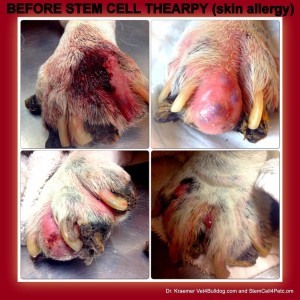Stem Cell Therapy for Skin Allergy in Dogs and Cats (Pets)

Stem Cell Therapy for skin allergy in Dogs and Cats (before and after), treated by Dr. Kraemeer
Stem Cell Therapy for skin allergies in dogs and cats is now being offered by Dr. Kraemer at Orange County California Location. Stem Cell Therapy (regenerative medicine) for dogs and cats has been extensively researched for its pain relief, anti-arthritis, anti-inflammatory, and immune modulation properties.
Atopic allergic itch dermatitis is one of the most common skin allergies in dogs and cats. Allergic itch skin dermatitis in pets is usually manifested by the dog or cat itching, biting and causing self-trauma which then leads to hair loss (alopecia) and often secondary bacterial skin infection (pyoderma) and secondary yeast infection (Malassezia). Stem Cell Therapy for skin allergies in Dogs and Cats is showing great therapeutic promise.
Atopic allergic skin dermatitis conjures up thoughts of stressed animals, unhappy owners, and frustrated veterinarians. Atopic itch allergic dermatitis in pets is possibly the number one reason for a veterinary office visit for a dog or cat owner. Atopic itch skin dermatitis in pets can be chronic and often requires treatment over an extended period of time, thus a major financial burden to the pet owner.
Stem cells are powerful healing cells that both you and your pet naturally store in a dormant form. Your dog or cat’s stem cells are extracted from their fat (adipose tissue) among a mixture of cells termed the Stromal Vascular Fraction (SVF). The SVF is rich in complementary cells and bioactive peptides that contribute to cell proliferation and tissue regeneration.
Dr. Kraemer’s in house stem cell therapy isolates stem cells from your dog or cat’s fatty tissue, then activates them (placing the cells into a hyperactive mode) and within hours, reintroduces them to injured and needed body parts.
Stem Cell Therapy for skin allergy in Dogs and Cats Maintenance:

Stem Cell Therapy for skin allergy in Dogs and Cats before treatment (Severe pododermatitis)

Stem Cell Therapy for skin allergy in Dogs and Cats after treatment by Dr. Kraemer
In contrast to your pet’s food allergies, avoiding implicated outdoor allergens (grass, weed, trees, etc.) and even indoor allergies (mold, dust mites, human dander, etc.) is usually difficult to accomplish. Traditionally, most dogs and cats who suffer from allergic itching atopic skin dermatitis are prescribed medication to help modify their symptoms (i.e. anti itching and biting rx). Additional medication can be prescribed to help decrease secondary infections (bacteria and yeast). Most of the traditional prescribed drugs lack effectiveness and have the potential for accumulative, adverse effects. In addition, over time they become costly and time-consuming, thus reducing the owner’s compliance. Dr. Kraemer has been offering stem cell therapy for dogs and cats for nearly a decade and is a leading provider of a number of non-pharmaceutical/alternative therapeutic modalities. These new-age, non-pharmaceutical alternatives such as Laser therapy, Pulse Electromagnetic Therapy (PEMT), and Platelet Rich Plasma (PRP) can all help manage your pet’s chronic pain and arthritis, as well as assist in treating a wide range of animal diseases and medical conditions. Dr. Kraemer also offers low-cost Cryobanking programs for future stem cell treatments.
Stem Cell Therapy for skin allergy in Dogs and Cats Rule of Thumb:
Stem Cell Therapy for atopic allergic itch dermatitis in pets is a low risk since you are reintroducing your pet’s own natural repair cells. Dr. Kraemer’s in-house stem cell therapy service has the advantage over other stem cell providers because the extracting, processing, and treating are all done on location the same day, thus eliminating unnecessary and unwanted cell death due to transportation and the time gap between extraction and treatment.
Stem Cell Therapy for skin allergy in Dogs and Cats Tips:

Stem Cell Therapy for atopic itch Skin Allergy in dogs and cats before & after photos treated by Dr. Kraemer
Dr. Kraemer’s Stem Cell Therapy for skin allergy in Dogs and Cats Tip #1: Any pet, dog, or cat when presented with itching, red irritated skin, patchy hair, bumps, color change, and thickness of the affected skin, should suspect allergic atopic itch dermatitis to be the cause.
Dr. Kraemer’s Stem Cell Therapy for skin allergy in Dogs and Cats Tip #2: Allergic atopic itch dermatitis in most pets, dogs, and cats is localized to the ears, paws, legs, armpits, and abdomen.
Dr. Kraemer’s Stem Cell Therapy for skin allergy in Dogs and Cats Tip #3: Common allergens affecting dogs and cats suspected of itch atopic allergic dermatitis include grass, weeds, and trees as well as indoor allergens like mold, dust mites, and human dandruff.
Dr. Kraemer’s Stem Cell Therapy for skin allergy in Dogs and CatsTip #4: For your pets with itching and allergy dermatitis who are under a year old , I recommend an elimination dietary trial to rule out food allergies
Dr. Kraemer’s Stem Cell Therapy for skin allergy in Dogs and Cats Tip #5: Platelet Rich Plasma (PRP) allows for an adjunctive autologous value to be added to the stem cell fraction. Platelet Rich Plasma is derived from an autologous whole blood sample from the patient and once processed yields many healing growth factors. PRP can help with the survival of the cells upon introduction to the patient, reduce inflammation as well as provide cytoprotective properties when transit is necessary.
Dr. Kraemer’s Stem Cell Therapy for skin allergy in Dogs and Cats Tip #6: You should use a flea preventative on your pet, especially in geographic locations where fleas are common.
Dr. Kraemer’s Stem Cell Therapy for skin allergy in Dogs and Cats Tip #7: OTC antihistamines can be used for dog skin allergies like atopic itch dermatitis but its therapeutic effect is questionable.

2 months post stem cell therapy treatment for a bulldog with a severe form of atopic allergic dermatitis
Dr. Kraemer’s Stem Cell Therapy for skin allergy in Dogs and Cats Tip #8: Treating allergic atopic itch dermatitis should involve bathing your pet with medicated shampoos and conditioners like Dr. Kraemer’s V4B Itchy Skin Medicated Shampoo as well as frequent use of medicated lotions like Dr. Kraeme’r V4B waterless lotions line. I usually also recommend topical medicated shampoos like Dr. Kraemer’s V4B Antiseptic Medicated Shampoo and V4B Yeasty Lotion to help manage the secondary infection.






